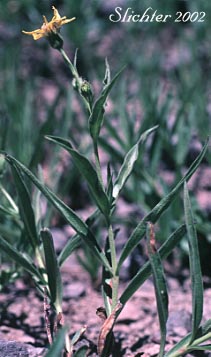
 The photo at right shows longleaf
arnica as found along the Wildhorse Trail at the Steens Mt., southeastern Oregon...........July
16, 2002.
The photo at right shows longleaf
arnica as found along the Wildhorse Trail at the Steens Mt., southeastern Oregon...........July
16, 2002.
Longleaf arnica is an attractive perennial wildflower often found in large clumps which are the result of a much branched system of rhizomes. The numerous stems contain mostly 5-7 opposite pairs of leaves and range from 30-60 cm high. The lower leaves often begin whithering by bloom tim, and the mid and upper leaves are often quite large, measuting from 5-12 cm long and from 1-2 cm wide. Individual leaves are narrowly lanceolate or lance-elliptic in shape, tapering gradually to an acute tip. The margins are mostly entire or occasionally slightly toothed. The herbage is somewhat rough and occasionally sticky.
The flower heads are several to many, with the involucres from 7-10 mm high. The 13-21 bracts are lanceolate in shape and densely glandular hairy with pointed tips. The 8-13 rays are yellowish and 1-2 cm long, surrounding the central disk (See photo above.).
Longleaf arnica may be found about seeps and springs as well as on moist cliffs and streambanks at middle and upper elevations in the mountains. Its elevation range is 2100-3250 meters.
Longleaf arnica may be found from the Washington Cascades south to the Sweetwater and White Mts. of California and east to Montana, southwestern Alberta, and Colorado and central and southwestern Utah.